Getting Around Amsterdam

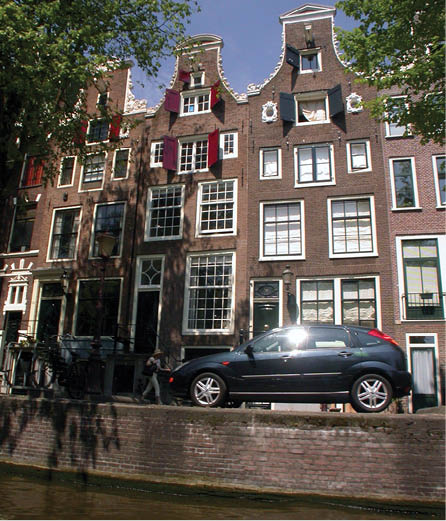
Gabled townhouses line the canals of Amsterdam.
Amsterdam is connected with the North Sea by the North Sea Canal, which opened in 1876, and is transited by cruise ships that travel from the sea locks at the seaside town of IJmuiden to the Amsterdam Cruise Terminal – a distance of 15.5 miles (25 km). Some ships dock at IJmuiden’s Felison Cruise Terminal (which opened in 2012). Passengers travelling between Felison Terminal and Amsterdam or the airport can utilize cruise line shuttles, taxis or the public bus/train system. Amsterdam’s cruise terminal is adjacent to the historic city centre and provides a variety of services, including shops and tourist information. Passengers can reach the nearby city attractions by foot, public transport or touring boat, and a tram car travels from the passenger terminal to the city centre. Most of the large tour-boat companies are located around Central Station (a five-minute walk from the cruise terminal) and offer a variety of tours of the city’s canals and main attractions. The Canal Bus offers hop-on/hop-off sightseeing cruises and a day pass costs 18 euros. An IAmsterdam Card can be purchased at tourist information offices; the card offers unlimited travel on trams (the most efficient way to get around) and discounts for canal cruises, museums and other attractions (www.iamsterdam.com).

Central Station
Amsterdam is a city of 800,000 people and 600,000 bicycles, the trill of their bells alerting pedestrians who wander into the dedicated cycling lanes. Many of the streets are closed to cars and used only by buses, trams and taxis. Sturdy black bicycles, popular with the locals, can be rented at Central Station, Leidseplein and Dam Square. The daily rate is about 8 euros, and locks are included.

A sightseeing canal boat.
Amsterdam Airport Schiphol is connected by rail to Amsterdam’s main train station (Central Station); travel time is 15 to 20 minutes and a one-way ticket is about 4 euros. A taxi ride from the airport to central Amsterdam is about 30 minutes and will cost about 45 euros. Connexxion operates shuttle vans to a wide selection of downtown Amsterdam Hotels; the one-way fare is about 15 euros. Most major hotels provide a complimentary shuttle.
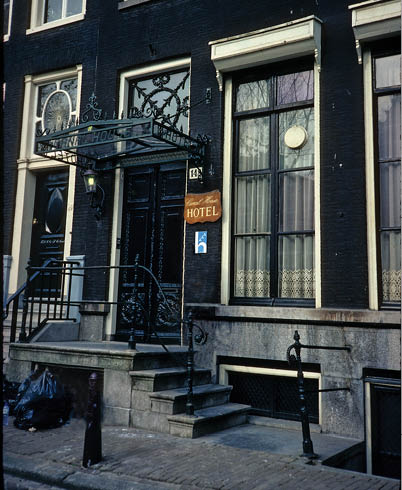
Canal House Hotel
Luxury hotels in Amsterdam include the Hotel Pulitzer (once owned by a member of the famous newspaper publishing family) which occupies a block of restored 17th-century canal houses on Prinsengracht in the fashionable Jordaan district. InterContinental Amstel Amsterdam, the city’s first grand hotel, was built in 1867 on the banks of the Amstel River. Royalty and rock stars have stayed at this palatial hotel and its Restaurant La Rive serves French-Mediterranean cuisine for which its has received a Michelin star.
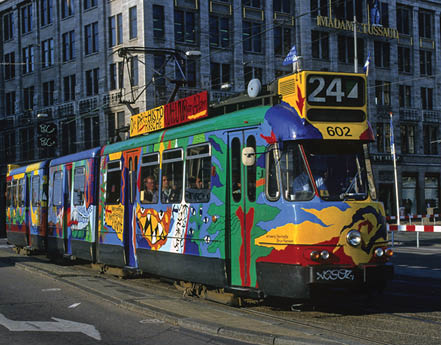
An Amsterdam tram car.
Boutique hotels include the 117-room Lloyd Hotel, built by the Lloyd shipping company in the 1920s and situated in the revitalized East Docklands area.
The Hotel Piet Hein is a contemporary boutique hotel located in the museum district near Vondel Park and the luxury shops along PC Hoofstraat.
The canal-side Ambassade Hotel is a four-star boutique hotel located in The Nine Streets district, as is the cozy, family-run Amsterdam Hotel Wiechmann.
The charming 26-room Canal House Hotel on Keizersgracht features a breakfast room overlooking the back garden.
A traditional Dutch breakfast spread consists of toast sprinkled with chocolate flakes, and crisp bread served with cheeses and ham.
Brown cafés, so named for their traditional dark-wood interiors that have deepened in tone over the centuries, are popular places to enjoy casual meals of soup and sandwiches, local cheeses and sausages, and a variety of Dutch beers, including Heineken and Amstel, or a shot of chilled jenever (a juniper-flavoured liqueur known as Dutch gin).

A street-lined canal in Amsterdam.
Cafe Karpershoek in the Bellevue Hotel is one of the oldest brown cafés in Amsterdam; this former sailors inn was built in 1606 when Martelaarsgracht (Martyrs Canal) was part of the harbourfront. The canal has since been filled in but the Cafe Karpershoek, frequented by locals and tourists, has retained its authentic atmosphere, with sand still sprinkled on the wooden floor to make cleaning easier (a traditional Dutch method).
Other popular brown cafes include Café de Druif near the Maritime Museum, and Café ‘t Smalle at Egelantiersgracht 12 in the Jordaan area. The nearby Café Papeneiland (at 2 Prinsengracht) is housed in a beautiful gabled property dating to 1642 and is famous for its homebaked apple pie, a caramelly version thick with cinnamon-scented apple.
Numerous cafés and restaurants are clustered around Leidseplein, which is a lively square filled with cafés, restaurants, theatres and outdoor entertainment. Chocolate lovers will want to sample the handcrafted chocolates sold by renowned chocolatier Puccini Bomboni at Singel 184 or at Staalstraat 17.
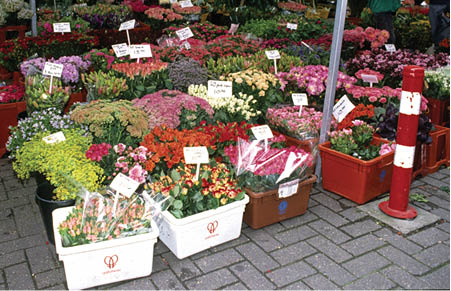
Flower Market.
Amsterdam is the place to browse for artwork, antiques and, if your budget allows, diamonds. Nieuwedijk is a major pedestrian shopping street leading from Central Station to Dam Square, location of De Bijenkorf (Amsterdam’s largest department store). Behind the Royal Palace is Magna Plaza – a shopping mall featuring designer clothes and fashion accessories in an elegant 19th-century building. Continuing south from Dam Square is the pedestrian shopping street Kalverstraat, which ends at the Floating Flower Market on Singel Canal where bulbs ready for export can be purchased. One of the prettiest places to shop is The Nine Streets district where the cobblestone streets are lined with designer boutiques, art galleries and cafés that straddle the 17th-century canals from the Singel to the Prinsengracht, about a five-minute walk from Dam Square.
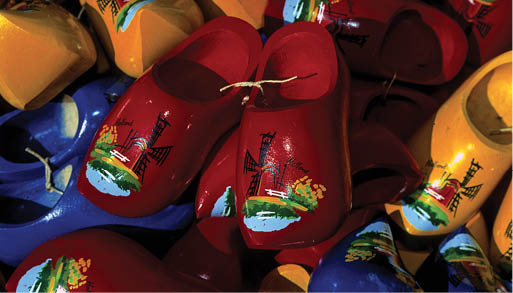
Souvenir wooden shoes.
Art galleries are located throughout the city and bookstores are concentrated around Spuiplein. An array of antique shops line Niewe Spiegelstraat, which runs between the Flower Market and the Rijksmuseum. Fashion boutiques are found along the Leidestraat (which leads to Leidseplein) and exclusive fashion shops are concentrated on PC Hoofstraat near the Rijksmuseum.
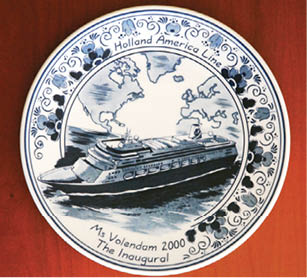
Hand-painted Delft porcelain.
Amsterdam has been a diamond centre for more than 400 years, and you can witness the art of diamond cutting and polishing on a guided tour at Gassan Diamonds (on Nieuwe Uilenburgerstraat, near Waterlooplein). Amsterdam Diamond Centre, which carries an extensive collection of loose polished diamonds as well as jewellery and watches, is located opposite the Royal Palace on Dam Square. The Waterlooplein Flea Market is situated in between the Opera House and Rembrandt’s House. The city’s sex shops are located in the Red Light District.
Map of Amsterdam

1. NEMO Science Museum – Amsterdam is a city packed with museums, and several are located in the immediate vicinity of the cruise port, such as the NEMO Science Museum.
2. Netherlands Maritime Museum – Another museum located near the cruise port.
3. Oude Kerk (Old Church) – The area immediately opposite the port is the city’s Red Light District, better known for its window displays of prostitutes than for Oude Kerk (Old Church), which is Amsterdam’s oldest monument, built in 1334. A parish church in the time of Rembrandt, whose first wife was buried here in 1642, the Oude Kerk is now a venue for exhibitions and concerts.
4. Amstelkring Museum (Our Lord in the Attic Museum) – Located nearby Oude Kerk, this museum is a clandestine Catholic church built on the upper floor of a canal house during the Reformation when open worship by Catholics was outlawed in Amsterdam.
5. Sex Museum – The Red Light District has a number of unusual museums including this one dedicated to the sensitive area of human sexuality. It is located at a busy spot in Amsterdam, at Damrak street, just in front of the Central Station. Throughout more than 20 years of its existence, the museum has collected many hundreds of interesting pieces of art, unique objects and rare old photographs without the bluntness of pornography.
6. Erotic Museum – A safe glimpse into the Red Light District establishments without being in one.
7. Hash, Marijuana and Hemp Museum – In recent years the city has been buying up bordellos and converting them into residential housing and designer showcases as part of a cultural revitalization project, and many of the area’s cannabis cafes are closing down and being replaced by restaurants and boutiques.
8. Nieuwe Kerk (New Church) – Located in Dam Square, this church was first built in the 15th century when the Oude Kerk became too small for the growing population of Amsterdam. Nieuwe Kerk, which was rebuilt in the Gothic style following a fire in 1645, is where royal weddings and investiture ceremonies are held.

Dam Palace and Nieuwe Kerk
9. Dam Palace – Built in the 17th century, was formerly city hall but became a royal palace in 1808 when the Kingdom of the Netherlands was briefly ruled by Louis Bonaparte, a brother of Napoleon. King Louis couldn’t decide which city should be the capital of his kingdom, but the constitution of 1814 made Amsterdam the capital.
10. Amsterdam History Museum – Located a few blocks south of Dam Square, this museum is housed in a collection of buildings that served as a 16th-century orphanage,
11. Begijnenhof – A garden courtyard entered off Spui along a narrow, vaulted passageway. This quiet courtyard contains a medieval church and is surrounded by old houses once occupied by Béguine nuns (including No. 34, the oldest house in Amsterdam).

Anne Frank
12. The Anne Frank House – The house where a teenaged Jewish girl hid during World War II with her family and four other Jews in a concealed annex within the warehouse of her father’s office building. Aided by their non-Jewish friends who secretly brought them food and other essentials, the Franks spent two years in hiding before they were discovered by the SS and hauled off to concentration camps where only the father survived. The two Dutch men who had helped the Frank family were imprisoned by the Nazis but the two female helpers were released after questioning and, upon returning to the ransacked annex, they found Anne’s diaries, notebooks and papers strewn across the floor, which they hurriedly retrieved and later returned to her father Otto after the war. First published in Amsterdam in 1947, Anne Frank, The Diary of a Young Girl was eventually translated into 67 languages and adapted for a Pulitzer-winning play and a screenplay starring Shelley Winters. Anne Frank’s candid diary has been read by millions of people and continues to touch the modern reader with its poignant portrayal of youthful optimism and courage in the face of evil. During the Nazi occupation of the Netherlands, 24,000 of the country’s 140,000 Jews went into hiding, aided by their fellow Dutch citizens, and of those 8,000 were discovered.
13. Westerkerk (West Church) – Located a block away from the Anne Frank House, this church was built between 1602 and 1631 in the Dutch Renaissance style, its tower topped with a copy of the crown of Hapsburg emperor Maximilian I.
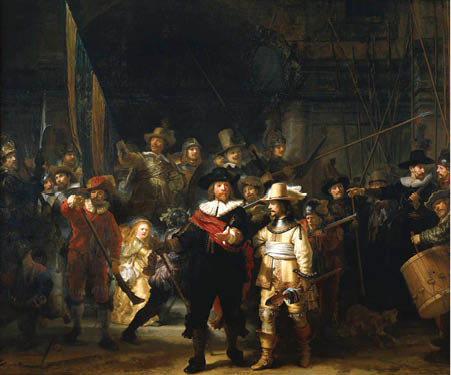
Rembrandt’s ‘Night Watch’
14. Rembrandt House Museum – This museum has preserved the famous painter’s three-storey house in which he painted many of his masterpieces. Rembrandt van Rijn, a miller’s son, was the greatest of the Dutch masters and he received valuable art training when he moved from his birthplace of Leiden to Amsterdam in 1624 to spend time in the studio of Pieter Lastman. Rembrandt’s portrait paintings were soon in demand, making him a wealthy man, and he was able to buy an impressive house for himself and his well-connected wife. Following her death, Rembrandt’s finances became strained and he was forced to move into more modest quarters.
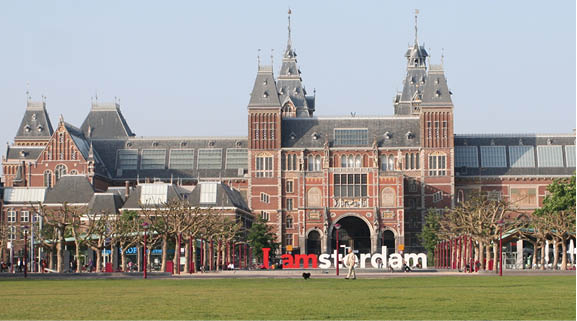
Rijksmuseum
Other museums in the vicinity of Rembrandt’s house include:
15. The Jewish Historical Museum – The museum is located in a group of four historical synagogues at the heart of the former Jewish quarter in the centre of Amsterdam.

16. The Dutch Resistance Museum – An interesting small museum that recreates the atmosphere of the streets of Amsterdam during the German Occupation and the Nazi rule in the Netherlands during the World War II.
17. The Hermitage Amsterdam Museum – A satellite of St. Petersburg’s Hermitage.
18. Willet-Holthuysen Museum – A fully furnished canal house, located on the other side of the Amstel, which was bequeathed to the city in 1895 by its last owner.
19. Rijksmuseum (National Museum) – Museumplein (Museum Square) is where Amsterdam’s three major art museums are located, including the world-famous Rijksmuseum (National Museum) which houses an outstanding collection of Dutch paintings and drawings from the Golden Age, its selection of masterworks including Night Watch by Rembrandt and The Kitchen Maid by Vermeer.
20. The Van Gogh Museum – Housed in a modern building, this museum contains the world’s largest collection of Van Gogh paintings and drawings, including The Potato Eaters, Bedroom in Arles and one of the Sunflower paintings.
21. Stedelijk Museum – Amsterdam’s museum of modern and contemporary art, housed in a recently refurbished 1895 building with a new extension.
22. Vondel Park – A large urban park near Stedelijk Museum containing green expanses, bicycle trails and a film museum.
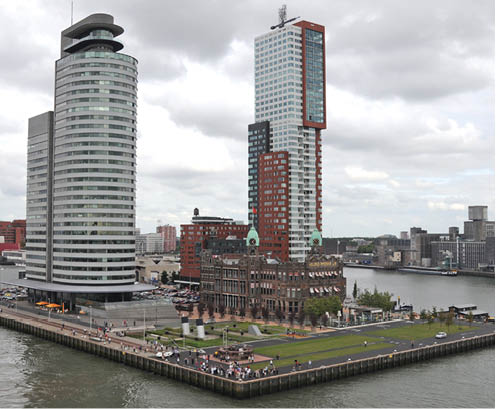
Rotterdam’s cruise quay is overlooked by the historic Hotel New York and modernist World Port Center.
Situated on the Maas River, Rotterdam is the industrial centre of the Netherlands and one of the busiest ports in the world. Its historic centre was completely destroyed by German bombardment in May 1940, with St. Laurens Kerk (Grote Kerk) the only building left standing amid the rubble. The post-war rebuilding and ongoing construction have made Rotterdam a showcase of modernist architecture.
The cruise ships dock in the revitalized docklands area of the city at Holland America Quay. The quay’s historic terminal building, which has been completely renovated, is an historic landmark of the thousands of emigrants who left Europe for the United States of America. Overlooking the quay is the Hotel New York, which once housed the original head office of Holland America Line. Towering nearby is the World Port Center, a high-tech design by Sir Norman Foster. Further along the harbourfront is the striking KPN Telecom Tower (designed by Rezno Piano) and the spectacular Erasmus Bridge, supported by a 445-foot pylon and nicknamed the Swan.
It’s a short walk across this modern suspension bridge to downtown Rotterdam, or you can take the water taxi service (about 3 euros each way). The city’s excellent museums include the Natural History Museum and the Maritime Museum, in front of which stands a statue called ‘Destroyed City’ which commemorates the WWII bombing of Rotterdam. The city’s main art museum is Boijmans-Van Beuningen, where you can view Tower of Babel by the Flemish painter Pieter Bruegel the Elder.
The small inner-city harbour of Delfshaven was spared during the WWII bombings and its historic waterfront is lined with gabled buildings housing trendy cafés and galleries. The Pilgrim fathers set sail for America from Delfshaven in July 1620 after meeting in the local Pilgrim Fathers Church.
Back across the river at Katendrecht is Holland America’s former flagship, Rotterdam V, permanently moored as a hotel, its hull painted the original gray.
Rotterdam shore excursions include a countryside drive to the preserved windmills at Kinderdijk, which is a UNESCO World Heritage Site located 20 miles (32 km) southeast of Rotterdam. Other area attractions are the picturesque town of Delft (famous for its pretty canals and locally crafted porcelain), the university town of Leiden (birthplace of Rembrandt) and the Hague, where places of interest include the House of Parliament and the Mauritshuis Museum with works by Rembrandt and other Dutch masters. Rail service connects all of these cities and towns.
